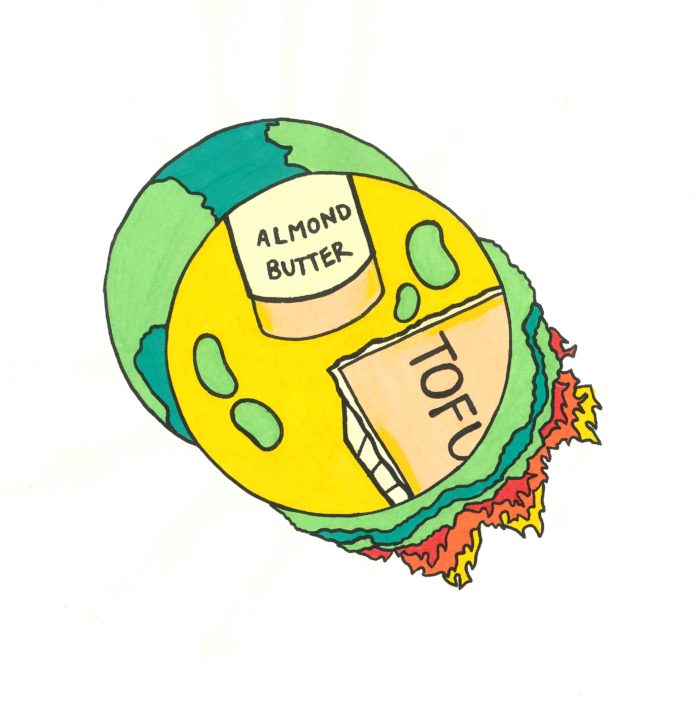Several weeks ago, the news that the Amazon rainforest was burning struck the world. Vegans everywhere took to social media, encouraging followers to go vegan to save the rainforest. The Amazon fires are inextricably linked to industrial agriculture and livestock. Brazil’s president Jair Bolsonaro ran on a platform to increase access of big industries to protected lands, on the basis that it is economically unproductive that indigenous communities control large areas of forest with such a vast potential for wealth.
Since his election in January, Bolsonaro has worked to dismantle environmental protections, similar to what Trump has been doing. Bolsonaro instructed the Brazilian Institute of Environment and Renewable Natural Resources to decrease fines for environmental crimes. He transferred the authority to safeguard indigenous lands from Brazil’s National Indian Foundation (FUNAI) to the Ministry of Agriculture, a win for the powerful industrial agriculture sector that funded his campaign.
Brazil is the world’s largest exporter of beef. Unsurprisingly, the beef industry receives a lot of blame for the fires. Countless Twitter and Instagram posts encourage readers to “Go Vegan to Save the Amazon,” but ignore this fact: Brazil is the largest producer of soybeans in the world, exporting $25 billion of the commodity each year.
Biology professor Shana Goffredi responded to this, saying, “I’m a big fan of vegetarianism at the very least because cattle is much more destructive to the planet in my mind. In this case, it’s complicated because our desire for those non-meat based products are also part of the problem.”
I recognize that soy, when consumed instead of beef, reduces the environmental impacts of raising animals such as copious methane emissions and water usage. Yes, being vegan is better for the environment, but being vegan doesn’t necessarily mean you’re saving the Amazon. The growth of both the animal and soy industries have come at the Amazon’s expense.
The soil in the Amazon is infertile and not ideal for farming because plants use most of the nutrients. Despite this, people still farm to make a living.
“People will survive by doing what they need to and if that’s cutting down the forest to grow crops that are really lucrative, then they will,” Goffredi said.
When the forest is clear cut, farmers face the predicament of growing crops in nutrient-poor soil. As a result, farmers set deforested areas on fire to turn the nutrients locked up in the forest biomass into soil-fertilizing ash, a technique called “slash and burn.” Intentional fires get out of control during the dry season — now exacerbated by climate change — and burn through the understory of nearby forests.
In the 2000s, public outrage over clear-cutting of the Amazon for soy production led to soy producers and environmental nongovernmental organizations signing the Amazon Soy Moratorium (ASM), banning the direct conversion of Amazon forests to soy after 2006. Recently, the moratorium’s effectiveness and overall impact has come into question. The moratorium’s goal — to stop forests from being directly cleared to plant soy — is quite different from actually halting deforestation in the Amazon.
Many soy farmers figured out they could get around the ASM by moving onto pasturelands cleared before 2008, and be in full compliance. This two-step double whammy process makes soy indirectly culpable: forests are cut to create pasture and those grazing lands are converted over time into soy fields. The cattle displaced then require new pasture, making the soy industry indirectly responsible for deforestation for the creation of pastures. Additionally, Highway BR-163 — built to transport soy from Brazil’s interior to export markets — has increased access of illegal loggers, land thieves and ranchers to the pristine forests.
So all that tofu, tempeh and soy milk we eat at the Marketplace contributes to the environmental degradation of the Amazon. Being vegan doesn’t exempt anyone from accountability for the destruction of the Earth’s most biodiverse ecosystem. We all must take responsibility for our lifestyles, and we can’t afford to be self-righteous about protecting the earth. We can’t talk about going vegan without talking about how ethical consumerism under late-stage capitalism requires a great deal of privilege, money and resources.
Indigenous Amazonians have undoubtedly been impacted by these fires, as well as corruption of their governments and agribusiness, to a greater extent and far longer than anyone writing about it on social media. There’s a great deal of ignorance in suggesting that soy ice cream will actually save indigenous people — and the planet — from this destruction.
According to Goffredi, when indigenous people are in control of the land, there’s usually much less habitat destruction and deforestation. One of the best ways to help stop the fires is to donate to organizations like FUNAI to support the protection of indigenous land rights.
Brazil will continue to play a significant role in providing our hungry and growing world with food. To preserve the country’s biodiverse forests, we must support the creation of innovative ways to increase productivity on already deforested land, incentivize sustainability and maintain biodiversity. Eating less meat will definitely help, but there is still a lot more that we can learn about and garner attention for when it comes to protecting the Amazon.
Maeve Secor is a sophomore biology major. She can be reached at msecor@oxy.edu.
![]()




































[…] This leads me nicely to the first claim, which says that vegans are responsible for the deforestation of The Amazon. […]